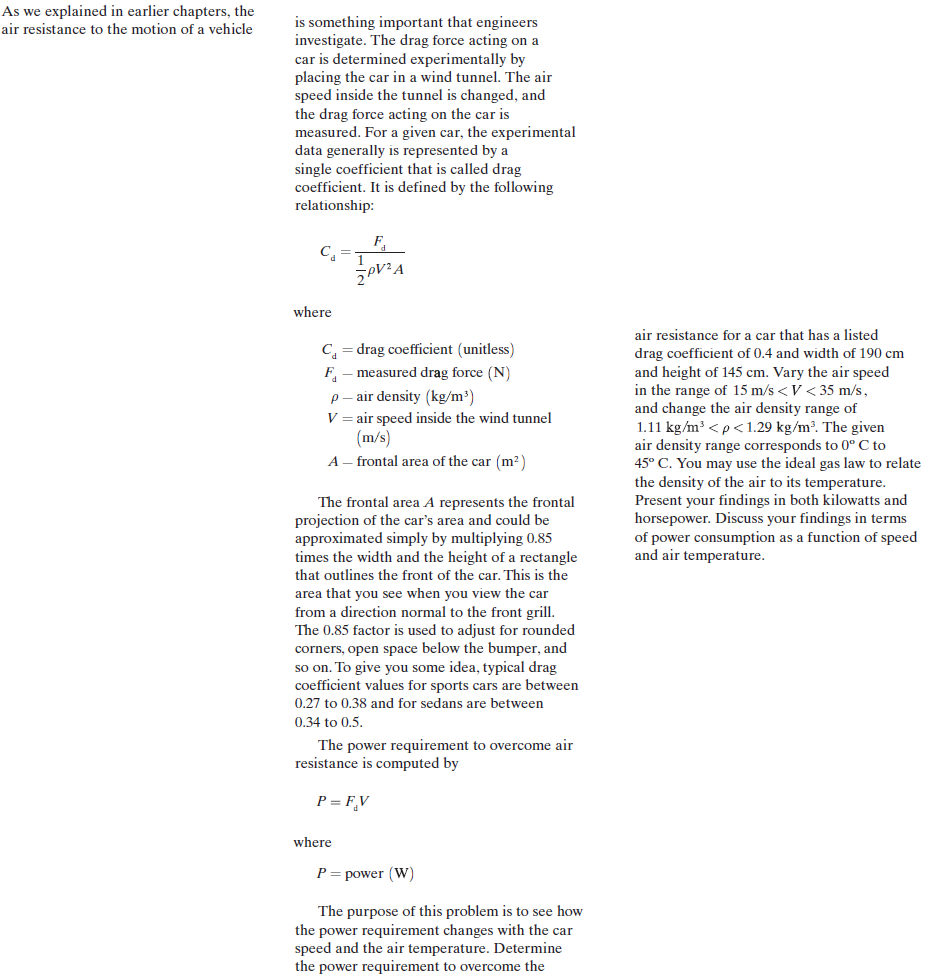As we explained in earlier chapters, the air resistance to the motion of a vehicle is something important that engineers investigate. The drag force acting on a car is determined experimentally by placing the car in a wind tunnel. The air speed inside the tunnel is changed, and the drag force acting on the car is measured. For a given car, the experimental data generally is represented by a single coefficient that is called drag coefficient. It is defined by the following relationship: F, where air resistance for a car that has a listed C, = drag coefficient (unitless) measured drag force (N) drag coefficient of 0.4 and width of 190 cm and height of 145 cm. Vary the air speed in the range of 15 m/s
As we explained in earlier chapters, the air resistance to the motion of a vehicle is something important that engineers investigate. The drag force acting on a car is determined experimentally by placing the car in a wind tunnel. The air speed inside the tunnel is changed, and the drag force acting on the car is measured. For a given car, the experimental data generally is represented by a single coefficient that is called drag coefficient. It is defined by the following relationship: F, where air resistance for a car that has a listed C, = drag coefficient (unitless) measured drag force (N) drag coefficient of 0.4 and width of 190 cm and height of 145 cm. Vary the air speed in the range of 15 m/s
Principles of Heat Transfer (Activate Learning with these NEW titles from Engineering!)
8th Edition
ISBN:9781305387102
Author:Kreith, Frank; Manglik, Raj M.
Publisher:Kreith, Frank; Manglik, Raj M.
Chapter8: Natural Convection
Section: Chapter Questions
Problem 8.36P
Related questions
Question

Transcribed Image Text:As we explained in earlier chapters, the
air resistance to the motion of a vehicle
is something important that engineers
investigate. The drag force acting on a
car is determined experimentally by
placing the car in a wind tunnel. The air
speed inside the tunnel is changed, and
the drag force acting on the car is
measured. For a given car, the experimental
data generally is represented by a
single coefficient that is called drag
coefficient. It is defined by the following
relationship:
F,
where
air resistance for a car that has a listed
C, = drag coefficient (unitless)
measured drag force (N)
drag coefficient of 0.4 and width of 190 cm
and height of 145 cm. Vary the air speed
in the range of 15 m/s <V < 35 m/s,
and change the air density range of
1.11 kg/m³ <p <1.29 kg/m?. The given
air density range corresponds to 0° C to
45° C. You may use the ideal gas law to
the density of the air to its temperature.
Present your findings in both kilowatts and
horsepower. Discuss your findings in terms
of power consumption as a function of speed
and air temperature.
F.
p - air density (kg/m³)
V = air speed inside the wind tunnel
(m/s)
A – frontal area of the car (m2)
The frontal area A represents the frontal
projection of the car's area and could be
approximated simply by multiplying 0.85
times the width and the height of a rectangle
that outlines the front of the car. This is the
area that you see when you view the car
from a direction normal to the front grill.
The 0.85 factor is used to adjust for rounded
corners, open space below the bumper, and
so on. To give you some idea, typical drag
coefficient values for sports cars are between
0.27 to 0.38 and for sedans are between
0.34 to 0.5.
The power requirement to overcome air
resistance is computed by
P = FV
where
P = power (W)
The purpose of this problem is to see how
the power requirement changes with the car
speed and the air temperature. Determine
the power requirement to overcome the
Expert Solution
This question has been solved!
Explore an expertly crafted, step-by-step solution for a thorough understanding of key concepts.
Step by step
Solved in 6 steps

Knowledge Booster
Learn more about
Need a deep-dive on the concept behind this application? Look no further. Learn more about this topic, mechanical-engineering and related others by exploring similar questions and additional content below.Recommended textbooks for you

Principles of Heat Transfer (Activate Learning wi…
Mechanical Engineering
ISBN:
9781305387102
Author:
Kreith, Frank; Manglik, Raj M.
Publisher:
Cengage Learning

Principles of Heat Transfer (Activate Learning wi…
Mechanical Engineering
ISBN:
9781305387102
Author:
Kreith, Frank; Manglik, Raj M.
Publisher:
Cengage Learning